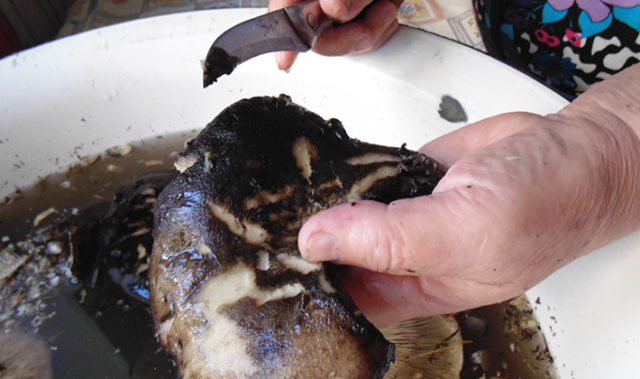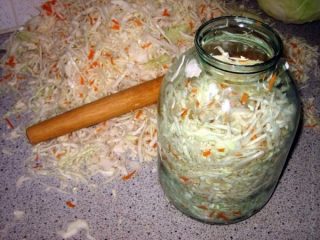Content
There is no need to peel milk mushrooms by removing the top skin. Everything about the mushroom is edible. It is important to properly process the harvested crop in a timely manner, otherwise the fruiting bodies will lose their taste and become unsuitable for consumption.
Do I need to clean milk mushrooms?
The concept of “cleaning a mushroom” does not always hide the action associated with removing the skin, spore-bearing layer from under the cap and other parts of the fruiting body. To find the correct answer to this question, you need to understand all the nuances. It’s worth starting with the fact that not all milk mushrooms can be eaten. Two types of mushrooms are conditionally edible:
- White milk mushrooms. The color of the growing fruiting body varies from white to slightly bluish. After soaking, the color changes. The mushroom takes on a gray or slightly greenish tint.
- Black milk mushrooms. Despite this name, the caps of the fruiting bodies are dark brown with a greenish tint.
These two species are united by a common habitat. Milk mushrooms grow in families in any forest, but are more often found among pine and birch trees.Fruiting bodies are recognized by their flat cap with a peculiar convexity. It is in this hole that most of the dirt that needs to be cleaned accumulates.

The slimy skin of mushrooms allows dirt, grass particles and leaves to stick to them.
The next thing you need to pay attention to is the skin. In milk mushrooms it is mucous, which promotes abundant adhesion of dust, grass, and pieces of dry leaves. This dirty coating must likewise be cleaned before preparing the fruiting bodies.
According to the rules, you need to clean white milk mushrooms or their counterparts with black caps a maximum of 5 hours after collection. You can wait a day, but part of the harvest will be discarded. Such strict requirements are due to the fact that mushrooms contain a lot of moisture in their bodies. Fruit bodies stored for a long time lose their taste, become sluggish, and change the structure of the pulp.
Video example of how to clean milk mushrooms quickly:
How to process milk mushrooms after harvesting
When the harvest is delivered home, you can’t wait too long.You need to immediately start preparing everything you need to help you clean the fruiting bodies efficiently. To complete the procedure you need:
- The round container is larger in volume than mushrooms. A saucepan, basin, bucket or plastic barrel will do. If there is too much harvest, several containers will be needed.
- Cold water is needed, preferably running water. If there is no running water, you can use a well. In the second option, you will often have to change the water manually using buckets.
- A knife with a sharp blade is necessary for trimming the lower part of the stem, damaged areas, and will help better clean dirt from the cap.
- A brush with soft bristles or a regular sponge is used when washing mushrooms. Cleaning with a device with rough bristles is unacceptable. It will damage the fruiting body.
When everything is prepared, an important moment begins - processing the milk mushrooms before cooking or salting.
How to quickly clean milk mushrooms from dirt
The harvest delivered from the forest must be cleaned, but first it is subjected to pre-treatment. First of all, sort out all the mushrooms. Old milk mushrooms, damaged by slugs or worms, and questionable fruiting bodies are thrown away. If the damage is minor, you can cut it with a knife. The sorted mushrooms are cleaned by hand from large debris. If necessary, clean the surface of the cap with a knife, scraping off adhering leaves and grass.

It is convenient to clean dirt from the surface of the cap with a knife.
After completing the “rough” cleaning, the milk mushrooms are washed with running water. It is optimal to load them in portions into a colander and place them under the water tap. The washed fruiting bodies are placed in a container and filled with cold water for 3 hours. During this time, the adhered dirt will fall off. Heavily soiled caps are cleaned with a brush.
Dirty water is drained, after which a new portion is immediately poured. To prevent milk mushrooms from floating, cover them with a large dish or lid and place a load on top, for example, a jar of water. Soaked mushrooms last for a day. During this time, the fine dirt that has eaten into the body of the milk mushrooms will fall away, and the insects will die. During the day, the water will have to be changed every 4-5 hours. If this is not done, the fruiting bodies will turn sour.
How to quickly wash milk mushrooms
After a day of soaking, the main dirt will fall off. The water is drained from the container. To further properly clean milk mushrooms after soaking, arm yourself with a brush or sponge. The washing process begins. Mushrooms are filled with clean cold water. Each cap is cleaned by rubbing in a circular motion with a brush or sponge. Cleaning the cap from the spore-bearing layer is a controversial matter. Usually sand accumulates between the plates, which is difficult to remove even by soaking. If the harvest was carried out in the forest on sandy soil, then it is better to cut out the spore-bearing layer with a knife. Rural residents who collect milk mushrooms in ecologically clean, non-sandy areas do not do this.

To wash mushrooms you will need a large container, such as a bucket.
The processed mushrooms are washed again and placed in another container with clean salted water. Here they have to get wet for another day. The next day they are simply washed under running water, no longer cleaned, and used for cooking.
How to properly clean milk mushrooms
Each processing of milk mushrooms at home follows its own recipe.Most often, mushrooms are salted, fried, pickled, and dishes are prepared from fresh fruiting bodies. Milk mushrooms are rarely allowed to be dried and frozen. This is due to the fact that the fruiting bodies are too watery. In addition, cleaning them involves several stages of soaking, but drying or freezing them cannot be done.

If during sorting you come across a questionable mushroom, it is better not to start cleaning it, but to throw it away immediately
Experienced mushroom pickers say that it is correct to wash black milk mushrooms without soaking. This royal mushroom can lose its delicious aroma and taste. As a last resort, to remove the dirt, the harvested crop can be soaked in salted water for no more than three hours.
How to properly clean milk mushrooms for pickling
Despite the many recipes, there are two types of pickling: cold and hot. However, for any option, processing milk mushrooms before salting follows the same principle:
- The harvested crop is sorted. Remove old and damaged fruiting bodies. Try to clean dirt and stuck leaves with a brush. If this is difficult to do, fill the milk mushrooms with water for 2 hours, after which the cleaning is repeated.
- Clean and washed fruit bodies are cut into 2, 3 or more parts, as required by the pickling recipe. Sometimes the cap is simply separated from the stem.Advice! The tastiest things to pickle are the caps. In many recipes, the stems of the milk mushrooms are removed and used to prepare other dishes, such as caviar.
- Even if you use the hot salting method, sliced mushrooms need to be soaked before cooking. Heat treatment will not help get rid of bitterness. The fruiting bodies are placed in a container of a suitable size and filled with cold salted water. The duration of soaking depends on the quality of the fruiting bodies. It's better not to rush.If cold salting is provided, then soaking can be extended to 2-3 days.
- After soaking, the fruiting bodies are washed several times and inspected. If everything is fine, they are sent for salting. No further preparatory steps are needed if the cold method is chosen. When hot salting is provided, you need to process the raw milk mushrooms by boiling.
To cook mushrooms, place them in a saucepan. Water is poured in such a quantity that the bodies float freely. After boiling, cook over low heat for 15 minutes. The boiled product is discarded in a colander, left to drain, and then sent to salting.

The processing must be carried out correctly, otherwise the mushrooms will lose their taste and attractive color.
How to properly clean milk mushrooms before cooking
It must be remembered that milk mushrooms are conditionally edible mushrooms. Their body contains milky juice that can cause intoxication of the body. After harvesting, you should not delay processing, no matter what dish the mushrooms are intended for. If you put crops in the refrigerator, even for short-term storage, toxic substances will begin to be absorbed into the body. From a lack of oxygen, pathogenic bacteria will begin to multiply.

Before frying, it is optimal to sort large and small fruit bodies
To properly clean milk mushrooms, you need to follow the same steps as for pickling. Mushrooms are cleaned of dirt, washed, and soaked. The only difference is the need for cooking. In addition, it is optimal to sort the fruiting bodies by size.It is more convenient to cook small and large specimens separately, since the first ones will fry or boil faster, while the others will take longer.
Useful tips
To make the harvest a pleasure, you need to take the advice of experienced mushroom pickers:
- a small knife with a sharp blade made of stainless metal is used for cleaning;
- you cannot overdo it with soaking, otherwise the fruiting bodies will lose their aroma and taste;
- after cleaning and soaking, the milk mushrooms are immediately processed without being sent for storage;
- You cannot use a pan made of copper, cast iron, or aluminum for cooking;
- Mushroom dishes cannot be stored for a long time, especially if they contain potatoes.
If, after cooking or processing, the appearance of the fruiting bodies is in doubt, it is better to discard them.

Coarse dirt can be partially cleaned with a knife at the harvesting stage.
Conclusion
Cleaning milk mushrooms is no more difficult than other mushrooms. The main thing is to follow the processing rules and not ignore the requirements specified in the recipe.










